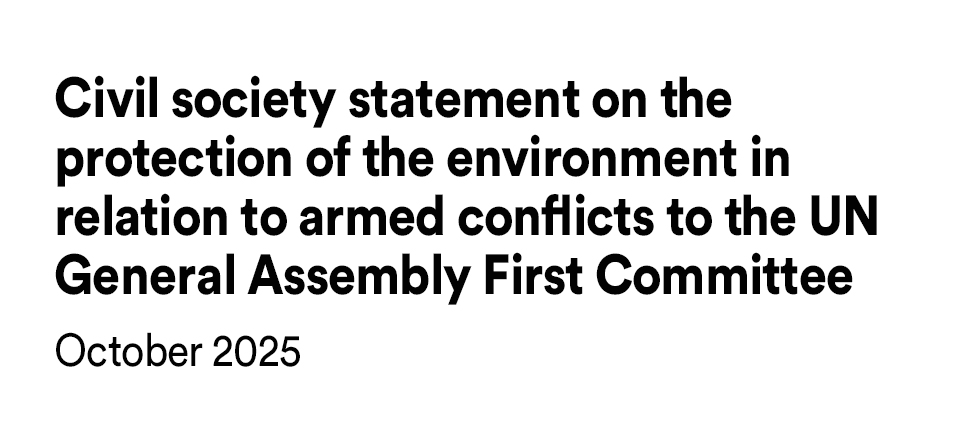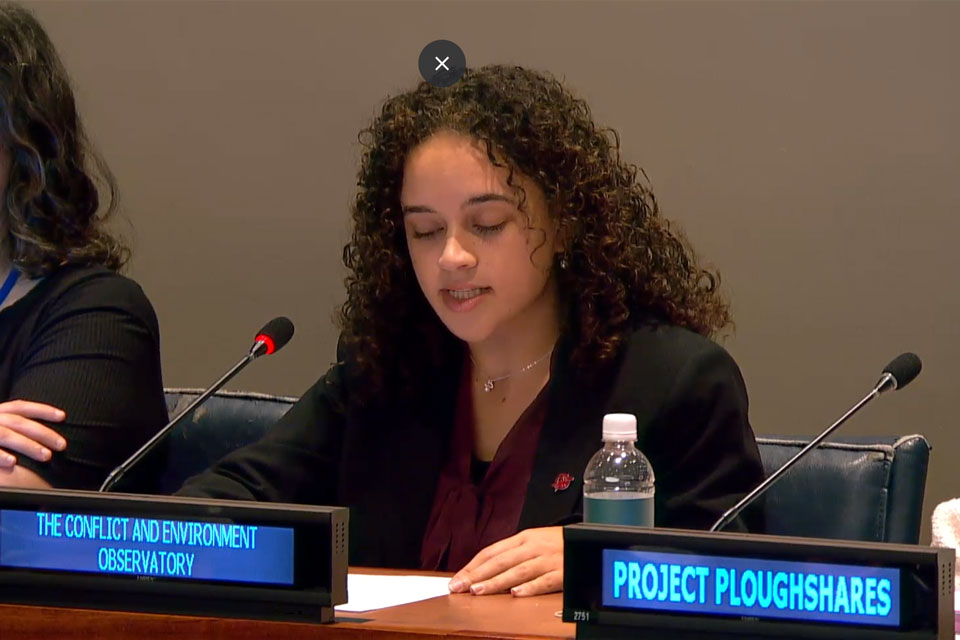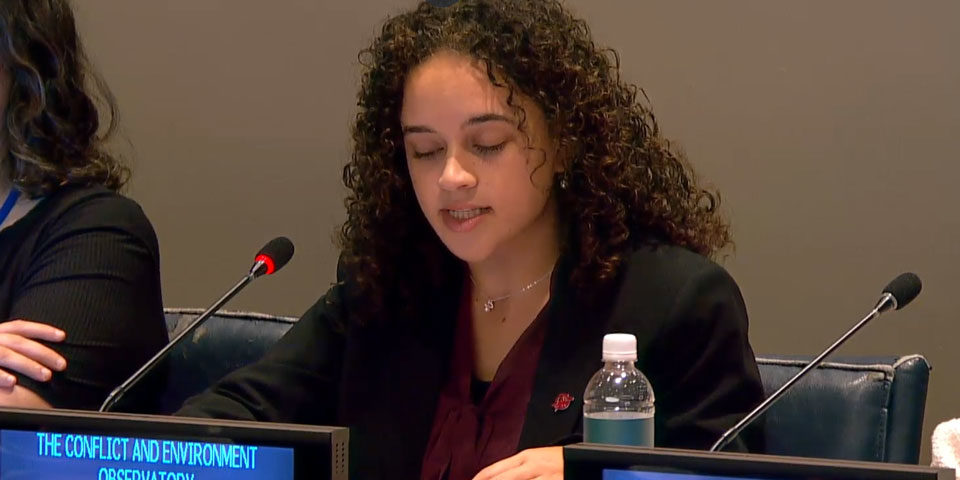
Published: October, 2025 · Categories: Publications, Law and Policy
Statement drafted by PAX and CEOBS and delivered by Malaika Walker of Pace University. For more exploration of the themes in this statement see the chapter on conflict and the environment in Reaching Critical Will’s 2025 First Committee Briefing Book.

Honourable Chair, distinguished delegates,
The scale of environmental devastation caused by armed conflicts and military activities is accelerating humanitarian crises and ecological collapse in ways we can no longer afford to ignore. These impacts directly threaten human security and fundamental human rights, erode the life-support systems communities depend on, deepen vulnerability to the climate crisis, accelerate biodiversity loss, and undermine our shared prospects for peace and sustainable development.
Take, for example, the genocide in Gaza, where the intensity of explosive violence by Israel in densely populated areas is appalling. Beyond the tens of thousands of deaths, the population is facing acute and long-term environmental health risks at an existential level. Tens of millions of tonnes of contaminated debris and solid waste are leading to the spread of communicable diseases and exposing Gazans to hazardous pollutants. Military operations have destroyed over two-thirds of Gaza’s water infrastructure and have devastated 96% of its agricultural areas – eliminating livelihoods and ecosystems essential for the survival of the civilian population.
Or consider the severe yet underreported environmental consequences of the war in Sudan, where oil and energy facilities continue to be targeted – resulting in conflict-pollution and hindering the humanitarian response by disrupting access to electricity and water.
In Ukraine, Russia’s war is creating novel environmental risks – from the widespread use of drones to the unprecedented militarisation of nuclear facilities. In the Red Sea, attacks on commercial vessels and resulting oil spills have endangered fragile marine ecosystems and put livelihoods of coastal communities at risk. All these developments are deeply concerning.
Yet, environmental degradation arises not only from active hostilities but also from military activities in peacetime, including weapons production and testing. As highlighted in the latest report by the Special Rapporteur on Toxics and Human Rights, military activities leave behind toxic legacies with long-lasting consequences for both human health and the environment – often without accountability or remediation. Moreover, spiraling military expenditure diverts critical resources from climate finance and sustainability efforts, while increasing military emissions that are contributing to the climate crisis.
This is precisely why it is crucial for the First Committee to integrate environmental concerns in its deliberations on humanitarian disarmament, peace and security.
Chair,
Although the environment remains underprioritised in the context of armed conflicts and post-conflict recovery, this year has shown encouraging signs of progress. The International Criminal Court launched a policy initiative to advance accountability for environmental harm, while the International Court of Justice affirmed states’ obligations to protect the climate system – which should place militaries under greater pressure to report and mitigate their emissions.
We also welcome the growing attention to environmental harm within the UN Security Council’s Protection of Civilians agenda, as well as the increasing recognition of environmental risks related to nuclear weapons.
But the First Committee must do more to contribute towards protecting the environment from the consequences of armed conflicts and military activities. We therefore urge all Member States to:
- Raise concerns over the environmental dimensions of armed conflicts and militarism in national interventions;
- Champion the PERAC Principles on the protection of the environment in relation to armed conflicts, and support their implementation; and
- Commit to reducing military greenhouse gas emissions and enhancing transparency of military emissions reporting.
Protecting the environment is not a side issue – it is a matter of civilian protection, human rights, and lasting peace and stability. The evidence is overwhelming. The tools are available. What is needed now is the political will to act: to address the environmental dimensions of military activities and conflicts, and to prevent further destruction – for the sake of current and future generations.
Thank you.
This statement was delivered on behalf of the following organizations:
- Action on Armed Violence (AOAV)
- Article 36
- Campaign Against Arms Trade
- Campaña Colombiana Contra Minas
- Centro de Estudios Ecuménicos
- Conflict and Environment Observatory (CEOBS)
- DAWN
- Derchos de la Infancia y la Adolescencia, México
- Initiative Bonne Gouvernance des Ressources Naturelles au Kivu (IBGRNK)
- International Humanitarian Law and Youth Initiative (IHLYI)
- International Peace Research Association
- Legacies of War
- Mines Action Canada
- Mines Advisory Group (MAG)
- Nonviolence International
- Nonviolence International Canada
- Norwegian People’s Aid
- Organisation Internationale pour les Pays Les Moins Avancés (OIPMA)
- PAX
- Perú por el Desarme
- Saferworld
- Scientists for Global Responsibility (SGR)
- Security Research and Information Centre (SRIC)
- SEHLAC
- Single Mothers Association of Kenya
- Soka Gakkai International
- Space4Good
- Surge Africa Organisation (SAO)
- Vision GRAM-International
- Women’s International League for Peace and Freedom (WILPF)
- Women for Peace and Democracy Nepal





